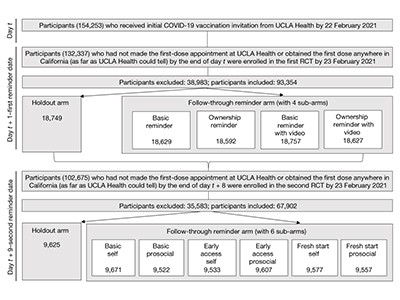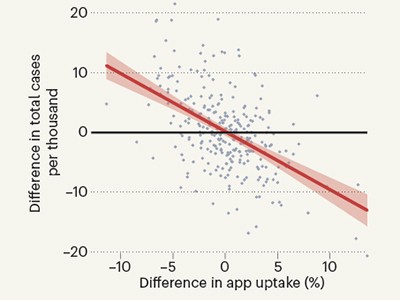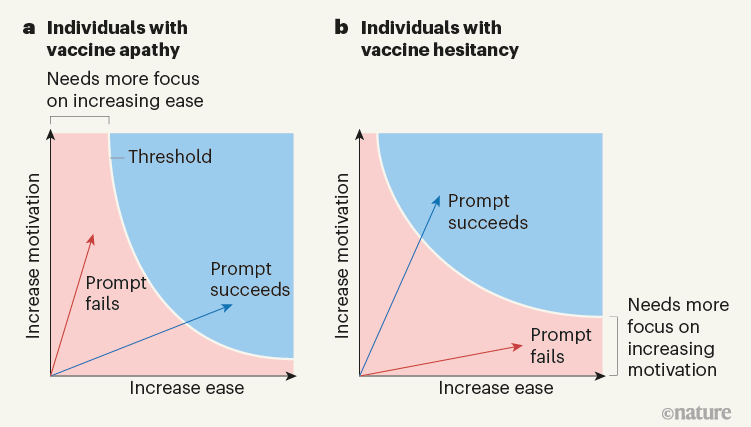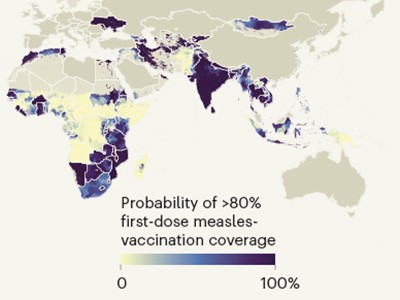Nudges are subtle changes to the way in which choices are offered or information is framed that can have an outsize impact on behaviour. As the supply of COVID-19 vaccines increases around the world, many nations are faced with the challenge of how best to encourage people to get vaccinated. Although various campaigns to do this have been implemented, little is known about which types of approach work and which do not. Writing in Nature, Dai et al.1 present findings from a large field experiment that reveal new insights into the three key elements that must be combined in strategies aimed at increasing the likelihood that people will get their vaccination against COVID-19.
Read the paper: Behavioural nudges increase COVID-19 vaccinations
Dai and colleagues set out to determine whether a single text message from a person’s health-care provider could change COVID-19 vaccination rates. In addition, they tested whether vaccination rates differed when recipients were told the vaccine was already theirs — that is, when they had psychological ownership of the vaccine. These text messages included phrases such as the vaccine has “just been made available to you”, and encouraged recipients to “claim your dose”. Such an approach has been used successfully to nudge influenza vaccination2, but has not previously been tested for vaccination against COVID-19.
In the main clinical trial, more than 93,000 individuals in a large health-care system who had not organized an appointment by the first weekday after an initial invitation were randomly placed in a control group or a test group and then followed for 4 weeks. These individuals were among the first wave of people eligible for vaccinations (owing to age or pre-existing medical conditions). Of the control-group individuals who did not receive any text-message reminders, 13.9% got vaccinated. Among individuals who received a simple text-message reminder with a link to a website where they could schedule a COVID-19 vaccine appointment, the vaccination rate increased to 17.1%. Adding language to induce psychological ownership further increased vaccination rates to 18.2%.
Contact-tracing app curbed the spread of COVID in England and Wales
Before this clinical trial, the investigators conducted an online experiment with individuals participating as hypothetical patients. They found that asking individuals to watch a two-minute educational video on the vaccine led to slightly higher stated intentions to get vaccinated than were seen for individuals who had not watched the video. However, unexpectedly, when the authors added a link to this video in the text-messaging experiment, it led to slightly lower vaccination rates than did sending text messages alone.
These conflicting results might be explained by some key differences between the two studies. For example, the online group of hypothetical patients had a mean age of 37 years, and 100% were required to watch the video, whereas individuals in the clinical trial had a mean age of 73 years and only 21% watched the video. Although the precise reasons for the inconsistent effect of the video are unclear, these findings demonstrate the value of conducting rigorous testing of approaches in real-world groups of individuals, rather than hypothetical ones3.
So, how can we apply these findings to future vaccination efforts? According to the Fogg Behavior Model (see behaviormodel.org), three key aspects need to be combined to successfully nudge behaviour: ability to act, motivation and a prompt. Moreover, the best nudging approaches to use will vary depending on individuals’ attitudes towards the COVID-19 vaccine (Fig. 1). For example, individuals who are hesitant about the vaccination often have a strong emotional response to the risks and benefits of the vaccine, whereas those who are apathetic about it have weakly held attitudes and often have not invested much effort in considering vaccination4. Appropriately tailoring interventions to the population of interest is likely to lead to higher success than is a one-size-fits-all approach.

Figure 1 | Nudges to encourage vaccination uptake will depend on individuals’ attitudes. Nudges are ways in which information is presented or choices offered that drive behavioural change. Dai et al.1 report the effects of sending individuals text-message reminders to encourage them to book an appointment to receive their vaccine against COVID-19. According to the Fogg Behavior Model, nudges should combine three aspects for success: they should prompt an action, increase motivation and make action easier. But nudges need to be tailored to individuals with different attitudes. a, If individuals are apathetic about getting a vaccine, prompting nudges will need to focus more on making it easier to arrange an appointment. Dai et al. achieved this by including a link to the booking website in the text messages. b, If individuals are more hesitant about getting vaccinated, such nudges will need to focus on increasing motivation.
First, interventions should aim to make the intended behaviour easier. In this case, the text messages provided a link to schedule an appointment. This made setting up vaccination quick and convenient. This aspect of the intervention boosted vaccination rates the most and probably addressed barriers among people with vaccine apathy who were unlikely to go out of their way to look up scheduling information (Fig. 1a).
Precise mapping reveals gaps in global measles vaccination coverage
Second, interventions should focus on increasing an individual’s motivation for the intended behaviour. The text-message reminders that invoked psychological ownership probably boosted vaccination by increasing motivation. However, compared with the simple text-with-link intervention, the increase in vaccine uptake following this intervention was relatively small (about 1 percentage point). The investigators also tried sending a second text-message reminder after another eight days to those who had still not scheduled an appointment. Individuals in this group were probably more hesitant than were those who had already set up their vaccine appointment, and that second reminder did not change overall vaccination rates compared with the control group. Individuals with vaccine hesitancy thus might often require further approaches to increase motivation (Fig. 1b), either through other types of nudge or different approaches, such as incentives5,6.
Third, interventions should prompt action. Sending a text message to consider vaccination forces a person to think about the decision ‘now’, rather than relying on them to remember to think about it on their own. The best channel for sending the notification will probably vary for different groups of people. For example, someone who is not tech-savvy might respond better to a phone call.
Although even the best text-messaging approach in the clinical trial increased vaccination by only a few percentage points, one must keep in mind that these approaches were very low cost and, if applied on a broader scale, could lead to millions of extra vaccinations that might otherwise have been delayed or not occurred at all. Nudges can be an effective tool for changing an individual’s behaviour, but they must be carefully designed. As health systems, public-health agencies and other stakeholders look for methods to increase COVID-19 vaccination rates, they should consider ways to implement nudges that make getting a vaccine easier, that increase motivation and that prompt action.

 Read the paper: Behavioural nudges increase COVID-19 vaccinations
Read the paper: Behavioural nudges increase COVID-19 vaccinations
 Precise mapping reveals gaps in global measles vaccination coverage
Precise mapping reveals gaps in global measles vaccination coverage
 Contact-tracing app curbed the spread of COVID in England and Wales
Contact-tracing app curbed the spread of COVID in England and Wales







